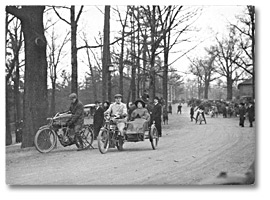
Table of Contents
Home | A Wilderness Paradise | Impact of Improved Transportation: Waterways
Impact of Improved Transportation: The Spread of the Railway
Impact of Improved Transportation: The Lure of the Wilderness
Impact of Improved Transportation: Cottages, Camps and City Parks
Government and the Tourism Industry: Growth of the Park System
Government and the Tourism Industry: Promotion and Infrastructure
Government and the Tourism Industry: Expansion and Diversification
|
As remote wilderness areas became more easily accessible, more people sought escape from the hurried life of the cities by building waterfront cottages. Some were grand second homes, such as the Brackens Cottage designed for the Hon C. R Breckinbridge in Muskoka, while others were much more rustic. |
|
|
|
|
|
|
| |
Higher incomes and new labour laws providing people with increased leisure time meant that tourism was no longer just for the upper middle class. The emergence of the automobile industry in the 1920s improved access to cottage country, and a service industry of motor camps developed that made travel less expensive for people. |
|
|
| |
|
Campers could pitch their tents and make use of the cookhouse with firewood and running water. |
|
|
|
|
The love of the outdoors captivated everyone. With transportation easier, parents sent their children to summer camp for the fresh air and wilderness adventures. |
|
|
|
There were tourist and recreational opportunities close by as well. Cities created parks and pavilions. In Toronto, residents could take short excursions by carriage or tram to the Lake Shore and High Park.
Click to see a larger image (85K) |
 |
|
Children, adults and families appreciated a respite from school and work as they relaxed by the water of one of the province's many beaches. Toronto’s Sunnyside Beach is shown below in the summer of 1924. |
|
| |
A Wilderness Paradise | Impact of Improved Transportation: Waterways
Impact of Improved Transportation: The Spread of the Railway
Impact of Improved Transportation: The Lure of the Wilderness
Impact of Improved Transportation: Cottages, Camps and City Parks
Government and the Tourism Industry: Growth of the Park System
Government and the Tourism Industry: Promotion and Infrastructure
Government and the Tourism Industry: Expansion and Diversification

![Photo: Cottage and boathouse by the water [Kingston area], [ca. 1905]](pics/3905_3_men_cottage_270.jpg)
![Photo: Two men and two women on rocky outcrop at Charleston Lake, [ca. 1919]](pics/13677_hikers_270.jpg)
![Photo: Lunch for two, [1923]](pics/26610_tea_chipmunk_270.jpg)
![Photo: Two women in a canoe, [1903]](pics/3812_women_canoe_520.jpg)
![Photo: Camp office at tourist camp in Midland, [ca. 1915]](pics/4113_camp_office_520.jpg)

![Photo: American tourists, Midland, [ca. 1930]](pics/12391_american_tourists_270.jpg)
![Photo: Summering at Camp Wabi Kon, Temagami, [between 1910 and 1930]](pics/12371_kids_at_camp_520.jpg)
